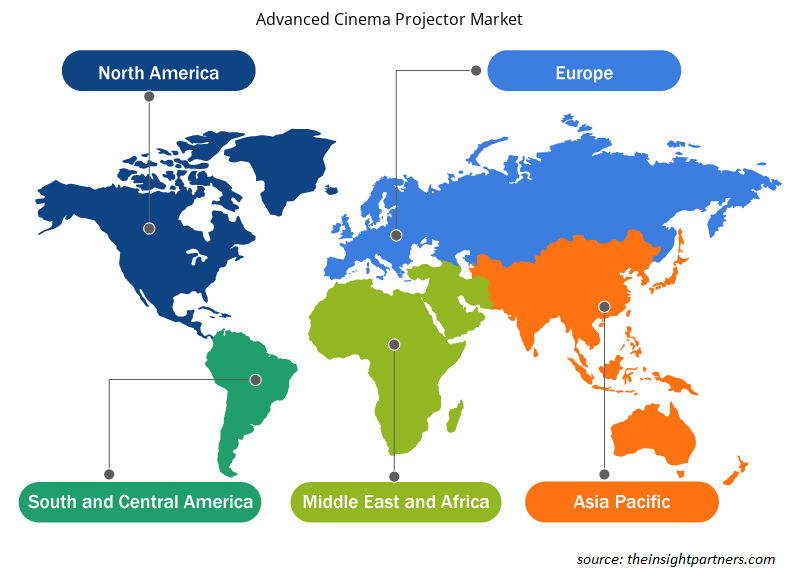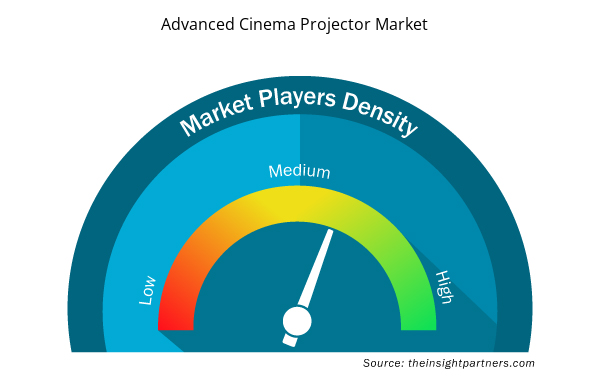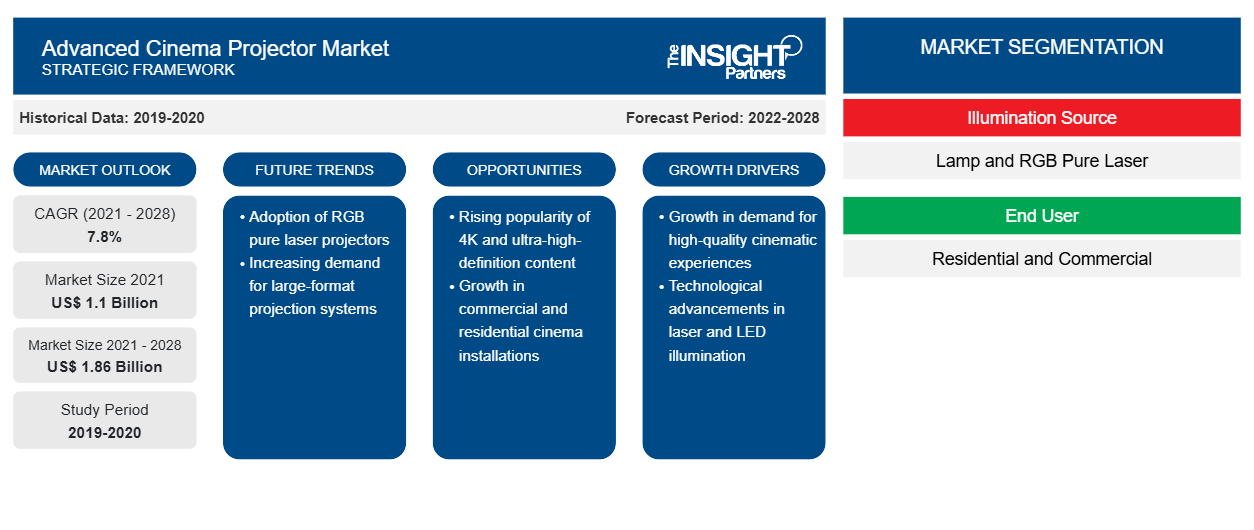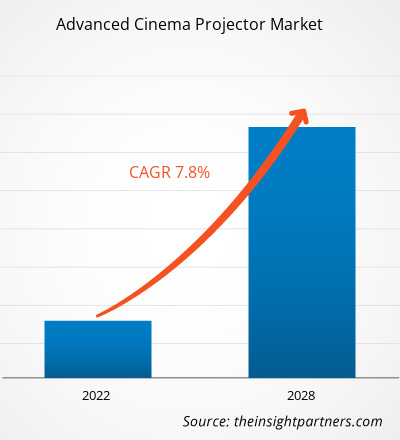[Forschungsbericht] Der Markt für fortschrittliche Kinoprojektoren soll von 1.100,69 Millionen US-Dollar im Jahr 2021 auf 1.861,33 Millionen US-Dollar im Jahr 2028 wachsen; von 2021 bis 2028 wird mit einer durchschnittlichen jährlichen Wachstumsrate von 7,8 % gerechnet.
Die rasant steigende Nachfrage nach fortschrittlichen Technologien in der Filmindustrie und die zunehmende Installation digitaler Displays treiben den Markt für fortschrittliche Kinoprojektoren weltweit an. Die fortschrittlichen Kinoprojektoren projizieren ein Bild effizient auf eine große Oberfläche wie eine weiße Leinwand oder eine Wand und werden als Alternative zu einem Fernseher oder Monitor verwendet, um Videos oder Bilder einem großen Publikum zu präsentieren. Das steigende verfügbare Einkommen der Menschen, die steigende Anzahl von Kinosälen/Theatern/Multiplexen und die steigende Zahl der Kinobesucher weltweit zwingen die Marktteilnehmer dazu, Kinoprojektoren mit fortschrittlicher Technologie zu entwickeln. Darüber hinaus steigert die zunehmende Entwicklung von 3D-Filmen durch die Produktionshäuser, um den Zuschauern ein verbessertes Erlebnis zu bieten, die Nachfrage nach fortschrittlichen 3D-Laserprojektoren.
Die Vorteile moderner Kinoprojektoren wie bessere Bildqualität, verbesserte Helligkeit und Farbfunktionen, die das visuelle Gesamterlebnis des Zuschauers verbessern, treiben den Markt weltweit an. Darüber hinaus ist während der COVID-19-Pandemie die Nachfrage nach modernen Kinoprojektoren für den Einsatz in Wohnhäusern als Heimkino enorm gestiegen, aufgrund der verbesserten Flexibilität, Farbgenauigkeit, unglaublichen Helligkeit und Tragbarkeit. Darüber hinaus unterstützt die steigende Nachfrage der Kunden nach Sportveranstaltungen in Clubs/Restaurants/Hotels und nach Freiluftkinos das Wachstum kommerzieller moderner Kinoprojektoren und fördert die Akzeptanz moderner Kinoprojektoren auf dem Markt.
Passen Sie diesen Bericht Ihren Anforderungen an
Sie erhalten kostenlos individuelle Anpassungen an jedem Bericht, einschließlich Teilen dieses Berichts oder einer Analyse auf Länderebene, eines Excel-Datenpakets sowie tolle Angebote und Rabatte für Start-ups und Universitäten.
- Holen Sie sich die wichtigsten Markttrends aus diesem Bericht.Dieses KOSTENLOSE Beispiel umfasst eine Datenanalyse von Markttrends bis hin zu Schätzungen und Prognosen.
Auswirkungen der COVID-19-Pandemie auf den Markt für fortschrittliche Kinoprojektoren
Die COVID-19-Pandemie hat mehrere Branchen weltweit hart getroffen und damit die Nachfrage nach verschiedenen Produkten der Elektronikindustrie dezimiert. Die Akteure der Elektronikindustrie verzeichneten im Jahr 2020 einen starken Rückgang ihrer Einnahmen, seit Anfang 2021 verzeichnen die Unternehmen jedoch in bestimmten Ländern ein bemerkenswertes Wachstum ihrer Produkte. Auch die Hersteller von Kinoprojektoren verzeichneten einen Umsatzrückgang, da die Nachfrage erheblich zurückging, da die meisten Kinos von den Regierungen geschlossen wurden, um die Ausbreitung von COVID-19 einzudämmen. Dies führte zu Umsatzeinbußen bei den Kinobesitzern, was sie wiederum daran hinderte, sich für fortschrittliche Projektionslösungen zu entscheiden, um das Kundenerlebnis zu verbessern. Dieser Parameter behinderte das Wachstum des Marktes für fortschrittliche Kinoprojektoren im Jahr 2020. Neben Kinos werden die Kinoprojektoren auch von verschiedenen Restaurants und Hotels beschafft, um ihre Kunden zu unterhalten. Das Auftreten und die rasche Ausbreitung des COVID-19-Virus zwangen die Gastronomie jedoch dazu, ihr Geschäft vorübergehend zu schließen, was wiederum den Kauf neuerer oder fortschrittlicher Projektoren einschränkte. Dies behinderte letztendlich die Geschäfte der Akteure auf dem Markt für fortschrittliche Kinoprojektoren. Neben der Nachfrageseite beeinflusste auch die Angebotsseite des Marktes für moderne Kinoprojektoren das Marktwachstum. Dies betrifft die Schließung der Grenzen, die zu Störungen in der Lieferkette mehrerer Komponenten/Teile führte. Dies führte zu einer Verringerung der Produktionsmengen und wirkte sich somit negativ auf das Marktwachstum aus.
Markteinblicke für fortschrittliche Kinoprojektoren
Steigende Nutzung moderner Kinoprojektoren im privaten Sektor weltweit
Moderne Kinoprojektoren für den Heimgebrauch erfreuen sich auf dem Markt immer größerer Beliebtheit, da die Kunden ein hochwertiges visuelles Erlebnis zu Hause haben möchten. Darüber hinaus fördern die zunehmende Kaufkraft und das steigende verfügbare Einkommen die Nutzung moderner Kinoprojektoren als Heimkinoanwendung. Auch die von den Regierungen eingeleiteten Lockdowns zur Eindämmung der Verbreitung von COVID-19 haben die Nachfrage nach modernen Kinoprojektoren weiter angekurbelt. Infolgedessen kaufen die Kunden neue Home-Entertainment-Produkte wie moderne Kinoprojektoren, um ihre Zeit in den eigenen vier Wänden während der Pandemie zu genießen. So hat BenQ im September 2020 in Indien den neuen BenQ TH585 eingeführt, einen Full HD-Heimunterhaltungsprojektor. Dieser neue Projektor bietet eine hohe Auflösung und Bildqualität, damit Kunden Filme und Shows zu Hause auf dem Bildschirm ansehen können.
Auf Illusionsquellen basierende Markteinblicke
Basierend auf der Beleuchtungsquelle ist der Markt in Lampen und RGB-Laser unterteilt. Die herkömmlichen Projektoren verwenden Lampen zur Lichterzeugung, und mit dem technologischen Fortschritt werden RGB-Laserprojektoren entwickelt, die eine verbesserte Licht- und Farbqualität bieten. Das Segment der RGB-Laser dominiert den Markt und wird voraussichtlich auch im Prognosezeitraum den Markt dominieren.
Endbenutzerbasierte Markteinblicke
Basierend auf dem Endverbraucher ist der Markt in Wohn- und Gewerbeimmobilien segmentiert. Das Gewerbesegment dominiert den Markt, da die meisten Kinos Laserprojektoren verwenden und die Nachfrage nach einer Umstellung von 2K auf 4K unter den Kinobesitzern wächst. Dies treibt das Gewerbesegment auf dem Markt für fortschrittliche Kinoprojektoren voran. Andererseits steigt mit dem weltweit steigenden verfügbaren Einkommen der Menschen und aufgrund der Auswirkungen von COVID-19 die Nachfrage nach Projektoren für den Wohnbereich weltweit.
Die Akteure auf dem Markt für moderne Kinoprojektoren verfolgen Strategien wie Fusionen, Übernahmen und Marktinitiativen, um ihre Position auf dem Markt zu behaupten. Nachfolgend sind einige Entwicklungen der wichtigsten Akteure aufgeführt:
- Im Jahr 2021 ist Cinionic (Barco NV) eine Partnerschaft mit Cine Colombia eingegangen. Der Deal ist der Höhepunkt der laufenden Unterstützung von Cinionic für Cine Colombia, den größten Kinobetreiber Kolumbiens mit 339 Kinosälen an 46 Standorten.
- Im Jahr 2020 gründeten Sharp Corporation und NEC Corporation ein Joint Venture, um ihre Geschäftsbereiche für Displaylösungen zusammenzuführen. Gemeinsam werden sie unter dem neuen Namen Sharp NEC Display Solutions Ltd. Displaylösungen wie Projektoren anbieten. Dieses Joint Venture würde eine neue Möglichkeit schaffen, seinen Kunden weltweit qualitativ hochwertige, innovative Lösungen anzubieten.
Regionale Einblicke in den Markt für fortschrittliche Kinoprojektoren
Die regionalen Trends und Faktoren, die den Markt für moderne Kinoprojektoren im Prognosezeitraum beeinflussen, wurden von den Analysten von Insight Partners ausführlich erläutert. In diesem Abschnitt werden auch die Marktsegmente und die Geografie für moderne Kinoprojektoren in Nordamerika, Europa, im asiatisch-pazifischen Raum, im Nahen Osten und Afrika sowie in Süd- und Mittelamerika erörtert.

- Erhalten Sie regionale Daten zum Markt für fortschrittliche Kinoprojektoren
Umfang des Marktberichts zu fortschrittlichen Kinoprojektoren
| Berichtsattribut | Details |
|---|---|
| Marktgröße im Jahr 2021 | 1,1 Milliarden US-Dollar |
| Marktgröße bis 2028 | 1,86 Milliarden US-Dollar |
| Globale CAGR (2021 - 2028) | 7,8 % |
| Historische Daten | 2019-2020 |
| Prognosezeitraum | 2022–2028 |
| Abgedeckte Segmente | Nach Beleuchtungsquelle
|
| Abgedeckte Regionen und Länder | Nordamerika
|
| Marktführer und wichtige Unternehmensprofile |
|
Dichte der Marktteilnehmer für moderne Kinoprojektoren: Auswirkungen auf die Geschäftsdynamik verstehen
Der Markt für fortschrittliche Kinoprojektoren wächst rasant, angetrieben durch die steigende Nachfrage der Endnutzer aufgrund von Faktoren wie sich entwickelnden Verbraucherpräferenzen, technologischen Fortschritten und einem größeren Bewusstsein für die Vorteile des Produkts. Mit steigender Nachfrage erweitern Unternehmen ihr Angebot, entwickeln Innovationen, um die Bedürfnisse der Verbraucher zu erfüllen, und nutzen neue Trends, was das Marktwachstum weiter ankurbelt.
Die Marktteilnehmerdichte bezieht sich auf die Verteilung von Firmen oder Unternehmen, die in einem bestimmten Markt oder einer bestimmten Branche tätig sind. Sie gibt an, wie viele Wettbewerber (Marktteilnehmer) in einem bestimmten Marktraum im Verhältnis zu seiner Größe oder seinem gesamten Marktwert präsent sind.
Die wichtigsten Unternehmen auf dem Markt für moderne Kinoprojektoren sind:
- Barco NV
- BenQ Corporation
- Christie Digital Systems
- Delta Electronics, Inc.
- Hitachi, Ltd.
Haftungsausschluss : Die oben aufgeführten Unternehmen sind nicht in einer bestimmten Reihenfolge aufgeführt.

- Überblick über die wichtigsten Akteure auf dem Markt für fortschrittliche Kinoprojektoren
Der globale Markt für fortschrittliche Kinoprojektoren ist wie folgt segmentiert:
Markt für fortschrittliche Kinoprojektoren – von Illusion Source
- Lampe
- RGB Reiner Laser
Markt für fortschrittliche Kinoprojektoren – nach Endbenutzer
- Wohnen
- Kommerziell
Markt für fortschrittliche Kinoprojektoren – nach Auflösung
- 2K
- 4K
Markt für fortschrittliche Kinoprojektoren – von Lumen
- 1000 – 5000
- 5001 – 10000
- 10001 – 30000
- Über 30000
Markt für fortschrittliche Kinoprojektoren – nach Geografie
Nordamerika
- UNS
- Kanada
- Mexiko
Europa
- Frankreich
- Deutschland
- Italien
- Russland
- Vereinigtes Königreich
- Russland
- Restliches Europa
Asien-Pazifik (APAC)
- China
- Indien
- Japan
- Australien
- Südkorea
- Restlicher Asien-Pazifik-Raum
Naher Osten und Afrika (MEA)
- Saudi-Arabien
- Vereinigte Arabische Emirate
- Südafrika
- Rest von MEA
Süd- und Mittelamerika (SAM)
- Brasilien
- Argentinien
- Rest von SAM
Firmenprofile
- Barco NV
- BENQ Corporation
- Christie Digital
- Delta Electronics, Inc.
- Hitachi Ltd.
- Infocus Corporation
- LG Electronics Inc.
- Optoma Corporation (Coretronic Corporation)
- Panasonic Corporation
- Sharp Corporation
- Historische Analyse (2 Jahre), Basisjahr, Prognose (7 Jahre) mit CAGR
- PEST- und SWOT-Analyse
- Marktgröße Wert/Volumen – Global, Regional, Land
- Branche und Wettbewerbsumfeld
- Excel-Datensatz



Report Coverage
Revenue forecast, Company Analysis, Industry landscape, Growth factors, and Trends

Segment Covered
This text is related
to segments covered.

Regional Scope
North America, Europe, Asia Pacific, Middle East & Africa, South & Central America

Country Scope
This text is related
to country scope.
Häufig gestellte Fragen
The top players in the advanced cinema projector market include LG Electronics, Panasonic Corporation, Barco NV, Epson Seiko, and Acer Inc. These companies are actively participating in developing robust projectors for cinema application (both residential and commercial). In addition, these players invest substantial capitals in respective R&D teams to design and develop projectors that meet the demands of the end users.
Western Europe is well-known for its better living conditions, with residents experiencing higher income levels. The high standard of living of people in western European countries drives the demand for advanced cinema projectors for residential use. Also, these countries comprise several organizations undergoing digital transformation, which is bolstering the growth of advanced cinema projectors. Furthermore, the European box office revenues accounted for 22% of the overall market share in 2019. Furthermore, a trend of shifting Hollywood productions to Europe has been witnessed in the last few years. As per the British Film Institute, in 2019, UK film & TV production increased by 11% in 2019 compared to 2018. These factor are responsible for decent growth of advanced cinema projector market in Europe.
The 4K advanced cinema projector refers to a class of projectors which is about four times the resolution of Full HD 1920 x 1080. These resolution projectors are generally being used in the range of 8 to 10 million pixels to produce a picture, compared to the Full HD. The higher pixel projector permits the user to have a closer viewing without losing the quality of the content on the screen and provides a better picture for audiences. In addition, several companies are venturing into the 4K space, which is another growth parameter for the 4K during the forecast period.
Presently, Asia Pacific held the largest revenue share of global advanced cinema projector market. The growth in APAC is driven by the rising construction of commercial and infrastructural spaces, particularly in the developing economies such as China, India, Malaysia, and Indonesia, among others.
Rising adoption of advanced cinema projectors across residential sector globally and accentuating demand for advanced cinema projectors in commercial applications are driving the growth of the advanced cinema projector market.
Based on end user the market is segmented into residential and commercial. The commercial segment dominates the market, as majority of the cinema theatres use laser projectors, and the demand for transition of 2K to 4K is growing among the cinema theatre owners. This is propelling the commercial segment in the advanced cinema projector market. On the other hand, with the growing disposable income of the individual globally and due to COVID-19 impact, the demand of residential projector is boosting across the globe.
Trends and growth analysis reports related to Electronics and Semiconductor : READ MORE..
The List of Companies - Advanced Cinema Projector Market
- Barco NV
- BenQ Corporation
- Christie Digital Systems
- Delta Electronics, Inc.
- Hitachi, Ltd.
- InFocus Corporation
- LG Electronics
- Optoma Corporation
- Panasonic Corporation
- Sharp Corporation
The Insight Partners performs research in 4 major stages: Data Collection & Secondary Research, Primary Research, Data Analysis and Data Triangulation & Final Review.
- Data Collection and Secondary Research:
As a market research and consulting firm operating from a decade, we have published and advised several client across the globe. First step for any study will start with an assessment of currently available data and insights from existing reports. Further, historical and current market information is collected from Investor Presentations, Annual Reports, SEC Filings, etc., and other information related to company’s performance and market positioning are gathered from Paid Databases (Factiva, Hoovers, and Reuters) and various other publications available in public domain.
Several associations trade associates, technical forums, institutes, societies and organization are accessed to gain technical as well as market related insights through their publications such as research papers, blogs and press releases related to the studies are referred to get cues about the market. Further, white papers, journals, magazines, and other news articles published in last 3 years are scrutinized and analyzed to understand the current market trends.
- Primary Research:
The primarily interview analysis comprise of data obtained from industry participants interview and answers to survey questions gathered by in-house primary team.
For primary research, interviews are conducted with industry experts/CEOs/Marketing Managers/VPs/Subject Matter Experts from both demand and supply side to get a 360-degree view of the market. The primary team conducts several interviews based on the complexity of the markets to understand the various market trends and dynamics which makes research more credible and precise.
A typical research interview fulfils the following functions:
- Provides first-hand information on the market size, market trends, growth trends, competitive landscape, and outlook
- Validates and strengthens in-house secondary research findings
- Develops the analysis team’s expertise and market understanding
Primary research involves email interactions and telephone interviews for each market, category, segment, and sub-segment across geographies. The participants who typically take part in such a process include, but are not limited to:
- Industry participants: VPs, business development managers, market intelligence managers and national sales managers
- Outside experts: Valuation experts, research analysts and key opinion leaders specializing in the electronics and semiconductor industry.
Below is the breakup of our primary respondents by company, designation, and region:

Once we receive the confirmation from primary research sources or primary respondents, we finalize the base year market estimation and forecast the data as per the macroeconomic and microeconomic factors assessed during data collection.
- Data Analysis:
Once data is validated through both secondary as well as primary respondents, we finalize the market estimations by hypothesis formulation and factor analysis at regional and country level.
- Macro-Economic Factor Analysis:
We analyse macroeconomic indicators such the gross domestic product (GDP), increase in the demand for goods and services across industries, technological advancement, regional economic growth, governmental policies, the influence of COVID-19, PEST analysis, and other aspects. This analysis aids in setting benchmarks for various nations/regions and approximating market splits. Additionally, the general trend of the aforementioned components aid in determining the market's development possibilities.
- Country Level Data:
Various factors that are especially aligned to the country are taken into account to determine the market size for a certain area and country, including the presence of vendors, such as headquarters and offices, the country's GDP, demand patterns, and industry growth. To comprehend the market dynamics for the nation, a number of growth variables, inhibitors, application areas, and current market trends are researched. The aforementioned elements aid in determining the country's overall market's growth potential.
- Company Profile:
The “Table of Contents” is formulated by listing and analyzing more than 25 - 30 companies operating in the market ecosystem across geographies. However, we profile only 10 companies as a standard practice in our syndicate reports. These 10 companies comprise leading, emerging, and regional players. Nonetheless, our analysis is not restricted to the 10 listed companies, we also analyze other companies present in the market to develop a holistic view and understand the prevailing trends. The “Company Profiles” section in the report covers key facts, business description, products & services, financial information, SWOT analysis, and key developments. The financial information presented is extracted from the annual reports and official documents of the publicly listed companies. Upon collecting the information for the sections of respective companies, we verify them via various primary sources and then compile the data in respective company profiles. The company level information helps us in deriving the base number as well as in forecasting the market size.
- Developing Base Number:
Aggregation of sales statistics (2020-2022) and macro-economic factor, and other secondary and primary research insights are utilized to arrive at base number and related market shares for 2022. The data gaps are identified in this step and relevant market data is analyzed, collected from paid primary interviews or databases. On finalizing the base year market size, forecasts are developed on the basis of macro-economic, industry and market growth factors and company level analysis.
- Data Triangulation and Final Review:
The market findings and base year market size calculations are validated from supply as well as demand side. Demand side validations are based on macro-economic factor analysis and benchmarks for respective regions and countries. In case of supply side validations, revenues of major companies are estimated (in case not available) based on industry benchmark, approximate number of employees, product portfolio, and primary interviews revenues are gathered. Further revenue from target product/service segment is assessed to avoid overshooting of market statistics. In case of heavy deviations between supply and demand side values, all thes steps are repeated to achieve synchronization.
We follow an iterative model, wherein we share our research findings with Subject Matter Experts (SME’s) and Key Opinion Leaders (KOLs) until consensus view of the market is not formulated – this model negates any drastic deviation in the opinions of experts. Only validated and universally acceptable research findings are quoted in our reports.
We have important check points that we use to validate our research findings – which we call – data triangulation, where we validate the information, we generate from secondary sources with primary interviews and then we re-validate with our internal data bases and Subject matter experts. This comprehensive model enables us to deliver high quality, reliable data in shortest possible time.


 Holen Sie sich ein kostenloses Muster für diesen Bericht
Holen Sie sich ein kostenloses Muster für diesen Bericht